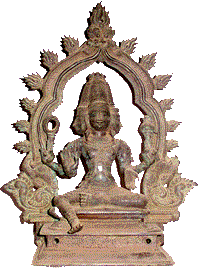Ayurveda
» Texts
Ayurveda Texts
 The
mythological origin of Ayurveda has a link with Brahma, the God of
Creation. This knowledge was passed directly to Daksha Prajapati in
the form of shloka sung by Lord Brahma, and this was in turn passed
down through a successive chain of deities to Lord Indra, the protector
of dharma. According to this account, the first human exponent of
Ayurveda was Bharadvaja, who learned it directly from Indra. Bharadvaja
in turn taught Ayurveda to a group of assembled sages, who then passed
down different aspects of this knowledge to their students. According
to tradition, Ayurveda was first described in text form by Agnivesha,
in his book the Agnivesh tantra. The book was later redacted by Charaka,
and became known as the Charaka Samhita. Another early text of Ayurveda
is the Sushruta Samhita, which was compiled by Sushrut, the primary
pupil of Dhanvantri, sometime around 5000 BC. The
mythological origin of Ayurveda has a link with Brahma, the God of
Creation. This knowledge was passed directly to Daksha Prajapati in
the form of shloka sung by Lord Brahma, and this was in turn passed
down through a successive chain of deities to Lord Indra, the protector
of dharma. According to this account, the first human exponent of
Ayurveda was Bharadvaja, who learned it directly from Indra. Bharadvaja
in turn taught Ayurveda to a group of assembled sages, who then passed
down different aspects of this knowledge to their students. According
to tradition, Ayurveda was first described in text form by Agnivesha,
in his book the Agnivesh tantra. The book was later redacted by Charaka,
and became known as the Charaka Samhita. Another early text of Ayurveda
is the Sushruta Samhita, which was compiled by Sushrut, the primary
pupil of Dhanvantri, sometime around 5000 BC.  Historians
believe that the documentation of Ayurveda started around 5000 years
ago. It is often claimed that Ayurvedic texts have their roots in
the vedic texts of 5000 BC. However, although both Ayurvedic and
vedic texts are written in Sanskrit, the two types of text are very
different in their style. All these texts are documented in palm
leaves called 'thaliyola'. Prior to this Ayurveda was preached and
practiced orally. Historians
believe that the documentation of Ayurveda started around 5000 years
ago. It is often claimed that Ayurvedic texts have their roots in
the vedic texts of 5000 BC. However, although both Ayurvedic and
vedic texts are written in Sanskrit, the two types of text are very
different in their style. All these texts are documented in palm
leaves called 'thaliyola'. Prior to this Ayurveda was preached and
practiced orally.
The three major Ayurvedic texts are:
1. Charaka Samhita(Text on internal medicine)
by Maharishi Charaka
2. Sushrutha Samhita (Text on surgery)
by Maharishi Sushrutha
3. Ashtanga Hrudaya & Asthanga Samgraha (Octopartite
science) by Maharishi Vagbhata
Additionally, there are three other works:
1. Madhavanidana (Pathology) by Maharishi
Madhava
2. Sarngadhara Samhitha by Maharishi Sarngadhara
3. Kasyapa Samhitha by Maharishi Kasyapa

|